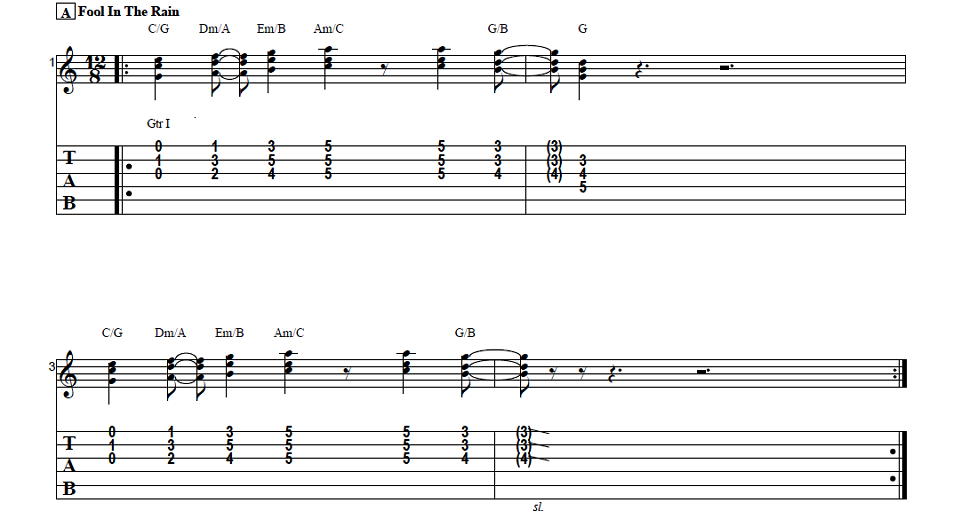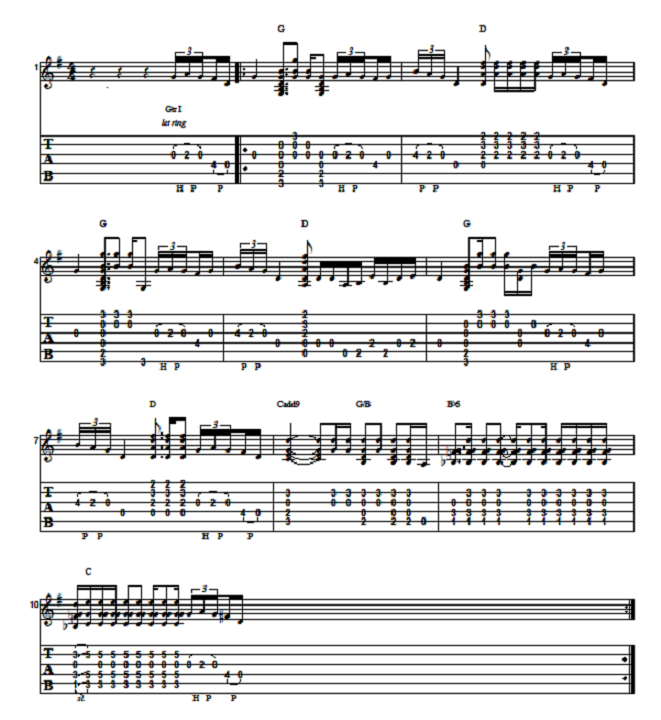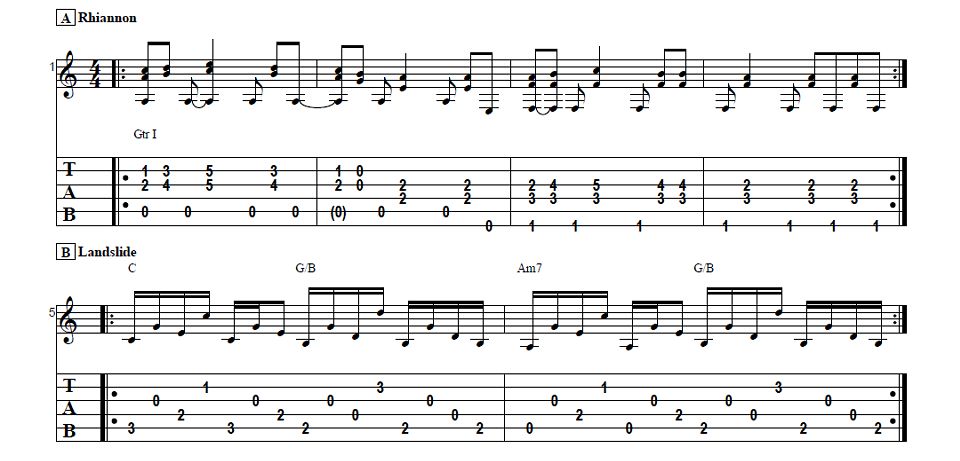Check out these 3 easy fun piano riffs transposed for guitar from Guitar Control instructor Darrin Goodman. Be sure to get the free tabs to go along with the step by step video instruction and you will be rockin’ these classic piano riffs on your guitar in record time.



Introduction
Hey everybody how’s it going? This is Darrin with GuitarControl.com bringing you this video lesson. Today I want to show you three cool riffs that are originally done on the piano and have been transposed to guitar just to kind of show you that this is like a really cool thing to do and sometimes there’s really cool piano stuff that just sounds really great on guitar. So be sure to click the link in the description for the tabs and let’s get close up and take a look at these.
Piano Riff-1 Imagine – John Lennon
All right so the first one we’re going to look at is Imagine from John Lennon. So for this one we’re starting off with it’s kind of like a C voicing, but I’m going to use my first and second finger; so I’ve got my second finger on the third fret of the A string and my first finger on the second fret of the D string and my thumb is going to be playing the A string and then I’m going to use my first finger to play the D string and my second finger to play the G string. This is eighth notes so; one and, then on the and of one I hit the A string. So we’ve got one and two and three and, and then on the downbeat of four I’m just going to move my first and second finger up a set of strings so now I’m plucking the G and B strings on the downbeat of four and then on the and of four I hit that bass note again. So that’s our first measure… Now we’re going to switch to an F over C (F/C). So if you just take your first finger and you move it from the second fret of the D string to the second fret of the G string and keep your middle finger where it is and then drop your third finger to the third fret of the D string so it kind of looks like you’re playing like an E major chord just up a half step and the picking is the same. So I start off I’m playing the D and G strings with my first and second finger still plucking that bass note on the A string; one and, two and, three and… Okay and then how we end that it’s got this little chromatic walk-up thing; so my first finger is already on the second fret of the G string I’m gonna pick that and then do a hammer-on to the third fret and then the fourth fret. So these are 16th notes and then this one’s an eighth note and that’s all on beat four and then it just repeats…
Piano Riff-2 Hurt – Christina Aguilera
All right so the next we’re going to look at is Hurt from Christina Aguilera and you’re probably already thinking why are you doing a Christina Aguilera song? Because this is actually a really cool song and it’s played on the piano, but transposed to guitar and it’s fairly easy to play; it’s one of those ones that kind of sounds harder than it actually is. So we’re starting off we have an E minor, but we’re just playing the top end of it; so we’re just playing on the D, G, B and high E strings and I’m just using my middle finger to play the second fret here on the D string. Then I’m going to pick and I’m just going to call off the strings so; four, three, two, three, one, three, two, three, and that’s kind of the picking pattern throughout this. So P, I, M, I, A, I, M, I, for those of you that know the PIMA stuff and that’s our first measure and it’s all eighth notes just one and, two and, three and, four and, and then the second measure it’s E minor over E flat (Em/Eb). So all we’re going to do is move that note here from the second fret of the D string to the first fret and then do the same picking pattern and then back to E minor again and that’s the first three measures. Then we’re going to go to a C and your middle finger is already where it needs to be so this is a really easy transition just to drop your other two fingers to make C. Now the picking pattern is the same, but I’m gonna move from being D, G, B and E I’m going to move down a set of strings so now my thumb is playing the A string, my first finger is playing the D string and my second finger is playing the G and my third finger is playing the B string and same picking pattern P, I, M, I, A, I, M, I, but again we’re on the different strings so it’s five, four, three, four, two, four, three, four, and then we switch to an A minor, really simple just move your third finger here and the same picking pattern. Now to a B7; second fret of the A string with my second finger, first fret of the D string with my first finger, second fret of the G string with my third finger and second fret of the high E with my fourth finger. Now we’re not actually playing the high E string on this so you don’t need to put that finger on there but that’s just the full voicing of the chord and it’s the same picking pattern that we just did on C and A minor and then back to E minor again… Em/Eb… and then it just kind of repeats…
Piano Riff-3 Let It Be – The Beatles
All right and then the last we’re going to look at is Let It Be by The Beatles. So you may very well already know how to play this by just strumming chords, but what I’ve done here is that this is so it kind of more follows like how the piano is being played. So this is fairly simple and we start off we’ve got C and my thumb is playing the A string, my first finger is playing the D string, second finger on the G string and third finger on the B string. So we’re going to pluck the D, G and B strings on the downbeat of one and then on the and of one we’re gonna follow that with our bass note; one and. Now for the downbeat of two we’re just going to take our fingers and move them from being on the D, G and B strings to the G, B and E strings and then still the same bass note so one and two and… Then we’re going to switch to a G chord and again we’re on D, G and B and then now our bass note moves to the low E and I move my fingers up again to G, B and E and then the bass note… that’s the first measure. Now we switch to an A minor and again we’ve moved from G, B and E to D, G and B and then up to G, B and E… Now here we’ve got a little bit of a different thing because again this is the piano that it was done on, so we’re adding in this note and I can’t see this being something someone would really throw in there if they were writing this on the guitar. So on the and of two we just hit the open G string and then we’re going to drop to F over C (F/C) and basically what it is it’s just your F chord but we’ve got a C in the bass, so I just take that F chord shape but I move my third finger from the third fret of the D string to the third fret of the A string and then drop my pinky; this is like my favorite and is pretty much exclusively how I play F, I just like the way it sounds. And then the same thing there; D and G, D, G and B and then G, B and E and that’s the second measure. So the first two measures… So starting on the third measure it’s just like the first so back to C, G and then on the fourth measure go back to that F/C and my thumb is going to play the A string, my first finger’s on the G, my second finger’s on the B and my third is on the high E and we’re going to play all of those together as a quarter note and then we’re gonna take just leave our first finger where it is and technically you can leave your third finger where it is too but I’m going to move it out of the way just so that there’s no problems with visual and if you want to keep your first finger here so it kind of keeps you grounded so you don’t get out of position take your second finger put it on the second fret of the D string and we’re going to play that and the G string open together two and then on the and two you just take your finger off and play the D and G strings both open and then C. So when I do this C my thumb still playing the A string, first finger is now on the D, second fingers on the G and third fingers on the B string and we hit that for beats three and four as it’s a half note. So we’ve got one two and three four and then it would just repeat…
Conclusion
All right so there you have it, three cool fairly easy but really nice sounding piano riffs transposed to guitar. So if you like this lesson be sure to give me a thumbs up and leave a comment down below if you have any questions about this or other guitar related topics. If you’ve not already done so please subscribe to the channel and hit that notification bell so you don’t miss any of the content that we upload throughout the week. Well that is all I have for you today. Thanks for watching and have a great day.






